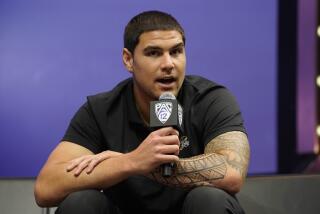Commentary : Steroid Problem Demands Taking a Closer Look
- Share via
NEW YORK — Run up a flag. Some professional football players have been detected using steroids. The first professionals have been caught and will sit out the first three games of the season for seeking better cheating through chemistry.
Ring a bell. The others are now free to go back to inflating muscles and boosting their speed by gulping and injecting anabolic steroids. There won’t be another test for them until next training camp.
No new program could have been without flaws in its first application. At least this is a statement that the NFL is acknowledging that using anabolic steroids is dangerous. It’s a first step toward dealing with a very real problem that has been dismissed for years as a requisite for playing the game.
Those suspensions came over the dead body of the union’s request for a court injunction. Remember, the NFL Players Assn. promised it would yell and shout and stamp its feet to try to block the league’s testing program.
Better the NFLPA should come forward with a better program for testing and discipline. The obligation of the union ought to be to protect the well-being of its members from the effects of steroids rather than trying to protect the users. The mine workers’ union insists that safety procedures are followed, rather than shielding those workers who won’t wear a helmet.
It is as much a matter of the football rules as the rule that prohibits a running back from wearing a spiked helmet. A steroid user gets an unfair advantage over the non-user.
“It was as if we ran 100 yards and they had a 3-yard head start,” was the way former New York Jets defensive end Barry Bennett described it. For some players the head start was enough to survive Tuesday’s 60-man limit, and for some others it meant being cut.
There is no longer any serious question that steroid use can help performance. Steroids, by themselves, don’t make an athlete bigger and faster, but they do enable him to train harder to get bigger and faster beyond the normal limits of the body.
Dr. Gary Wadler, author of “Drugs and the Athlete,” applies this equation: Force equals mass times acceleration. That means the bigger and faster the player, the more devastating the collison. Multiply that by the exponent of savagery caused by “roid rage” and you have the reason why the union and its players ought to acknowledge the safety issue.
There’s also evidence that the heart and kidneys are damaged, and that sexuality and personality are impaired by steroid use. A test at Harvard last year found psychotic problems in one-third of 41 admitted steroid users.
That means, to compete with steroid users an athlete must be willing to expose himself to health risks that should not be part of his game. It’s one thing to be willing to absorb the pounding of playing football, it’s quite another to be asked to accept long-term kidney damage for love of the game. It’s a real issue.
Labor and management are obligated to get off their adversary pedestals, stop linking programs against steroid use with negotiations for more meal money and deal with the issue. It has to be subject to collective bargaining, but not eternally obstructed.
According to Doug Allen, assistant executive director, the union is comparing the results with the results of its own voluntary test performed before players went to camp. If the union was really doing its job, it would be involved in its own program -- with or without the league -- rather than testing to protect against “false positives.”
The union objects to the guidelines set by Dr. Forest Tennant, the league’s drug adviser, but the NFL maintains that testing was conducted by Dr. David Black of the acclaimed Vanderbilt University steroid lab and processed at Vanderbilt and at the Calgary Olympic lab.
The real question of the testing regards not the 13 players suspended and the unnamed 11 who were cut before the results were announced -- the less than 2 percent who were detected -- but the nearly 99 percent who were clean or sophisticated enough to go through clean as a whistle.
They all knew the test would be given within 10 days of the opening of training camp, which should be warning enough for every player to cleanse his system. According to Wadler, steroids taken orally clear the system in three to four weeks, while injectables take about two months.
Players caught with that much advance notice, says Dr. Robert Voy, former physician to the U.S. Olympic Committee, are “so addicted to anabolic steroids that they couldn’t get off, or they were stupid.”
Wadler cites evidence that more than 7 percent of male high school seniors use steroids, whether or not they’re athletes, and 10 percent of all NCAA football players. There is a logical progression: If the best players move on to the next higher level, and if the use of steroids enables a player to make himself better ...
Bennett estimated that half of the linemen in the league used steroids at one time or another. In May, Atlanta Falcons tackle Bill Fralic told Congress that up to 75 percent of the linemen have used steroids at some point.
Allen objects that penalties for first steroid use are more “harsh” than that for “street drugs,” which calls for suspension only after a second incident. They are, but the steroid user gets an immediate playing advantage.
The only effective plan would be one that calls for unannounced testing, or enough testing that a player couldn’t slip a cycle of steroids between tests. The technology is coming that will detect more distant use.
Allen claims this as a positive, that less than 2 percent were caught. “I think this test certainly does contribute to reducing the public hysteria that completely exaggerates the level of steroid use,” he said.
No. Who’s fooled? What this test does is to say that the league and its players still have to come to grips with the problem.
More to Read
Go beyond the scoreboard
Get the latest on L.A.'s teams in the daily Sports Report newsletter.
You may occasionally receive promotional content from the Los Angeles Times.










